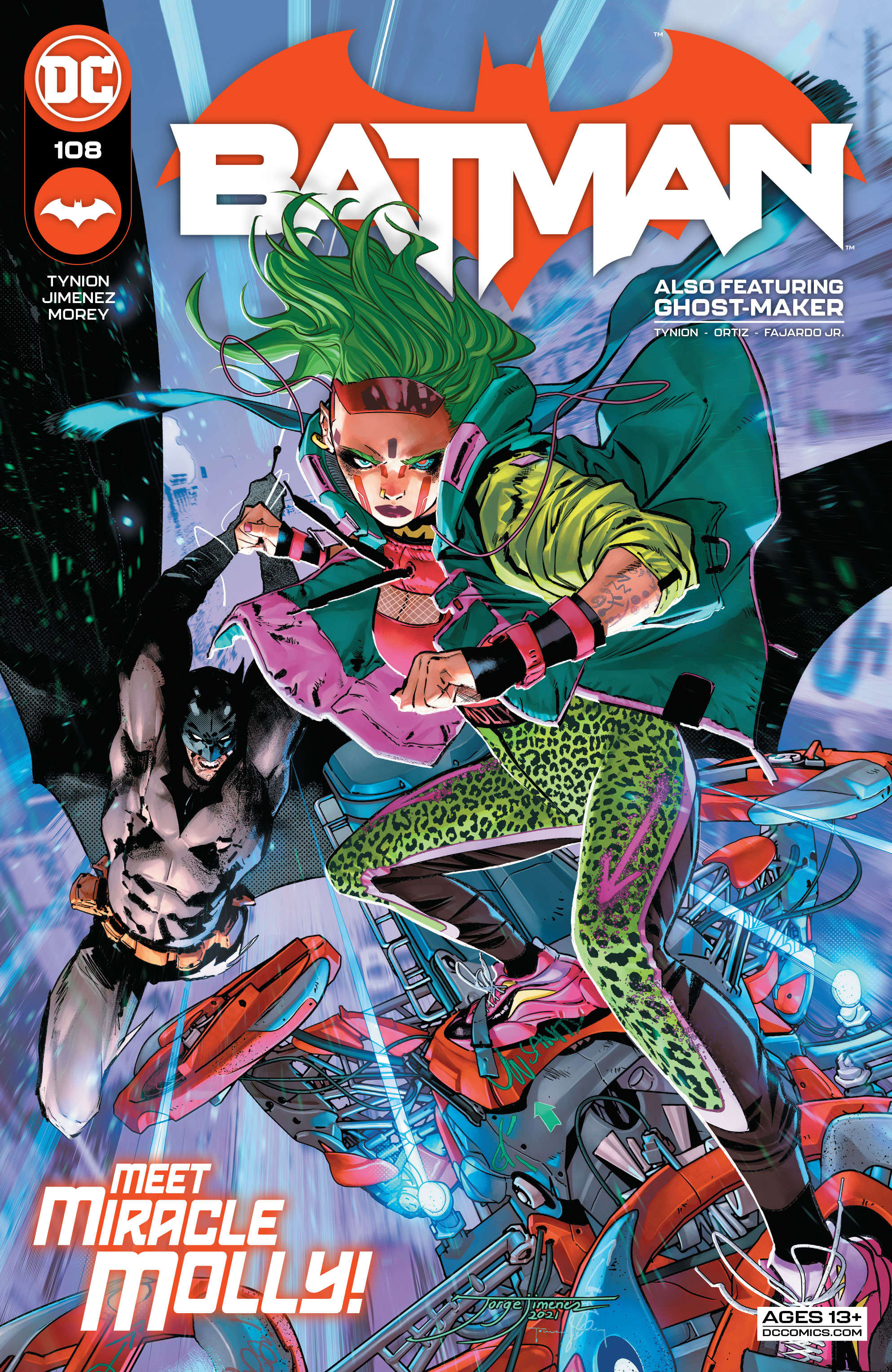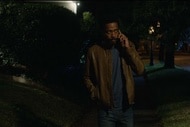Create a free profile to get unlimited access to exclusive videos, sweepstakes, and more!
Exclusive: Batman writer James Tynion IV on new rogue Miracle Molly and 'leaning into the weird' in Gotham

James Tynion IV has been writing Batman stories in one form or another for the last decade, and in that time he's gained an intimate familiarity with Gotham City and its many wild residents. That familiarity meant that, when he took the reins of the main Batman title early last year, it was with an eye toward infusing the new into the familiar Gotham landscape, adding characters and ideas that can be a part of Batman's world for years to come. It's an idea that's already given us major players like The Designer, Punchline, Ghost-Maker and, beginning this week in Batman #108, the mysterious and intriguing new figure known as Miracle Molly.
"She's the sort of rogue that I love writing in that she's not evil," Tynion told SYFY WIRE last week in discussing the new character he developed alongside Batman artist Jorge Jimenez. "Like, in writing Joker, Joker's an evil character. Even when he makes a point, it's not a good point. It's not a point you want him to be making, but with Miracle Molly, she's a person. She is a person who's trying to make the most of her life and trying to make Gotham City better and trying to reclaim the future for herself and other people. And she's willing to go very far in pursuit of those goals and then ultimately we will see her push further than Batman is comfortable with.
"She is a character who's never going to just be a member of the Bat-Family or something like that. She is someone who is ideologically opposed from Batman, but who Batman is going to have this [feeling of], 'You're so close to believing in the things that would make you part of the Bat mission.' And she thinks the same thing, it's like, 'You guys need to stop doing what you're doing and join us. And that's how we'll make change in the city.' I'm excited for people to see how the story plays out over the course of this larger Scarecrow narrative. And then I have some plans for where her story goes after this arc as well."
A major tipping point
As Tynion noted, Molly's arrival comes at a time when Batman has his hands full as Gotham City reaches what feels like a major tipping point. In the wake of the events of Joker War, an attack of Arkham Asylum has put the whole city on edge, and both city officials and residents are eager for someone to come along and bring change. Unfortunately for Batman, that includes a tech titan who wants to launch a new crime-fighting initiative in the city, the return of the Scarecrow and his new campaign of fear, and the Unsanity Collective, a group of cyberpunk-infused adversaries who believe the best path forward for Gotham City is to quite literally let go of all the traumatic memories and move forward with a clear, memory-wiped head.
It's through the Collective that Miracle Molly emerges as a key player. A tech wizard with the cybernetically enhanced ability to pick apart and reassemble basically any machine she sees, Molly has been glimpsed in the background in previous issues of the current Batman arc, "The Cowardly Lot," but in #108 this Tuesday she'll step forward in a big way as Batman makes an effort to dig deeper into what the Unsanity Collective is all about.
For Tynion, Molly and the Collective surrounding her emerged out of some very particular thematic needs for the current major arc of the book, namely the need for an ideological counterpoint to Scarecrow's reign of terror.
"With Miracle Molly and the Collective, what they really believe is that you need to let go of the past. You need to let go of your trauma and then embrace the future and let it change you into what you have the potential to become next, and it's sort of rooted in ideas of transhumanism and stuff like that," Tynion explained. "That is very much the ethos that I wanted to do. Scarecrow's plot is also going to be about the evolution of Gotham City, but he believes, of course, that you need to lean into the trauma, that the trauma is the key essence for human evolution, that fear is the essential driving evolutionary force of humanity.
"So in trying to build these characters, it is sort of figuring out what are the larger statements being made in the story and who were the people making those statements? And then ultimately Batman's the character kind of in the middle, like sort of being pulled between these poles where obviously Batman's entire core philosophy is built off of self and betterment of overcoming his own personal trauma. That's who Batman is, and Miracle Molly and the Unsanity Collective are a pure rejection of that entire methodology, but they have a point and they have a kind of utopian point of view. And then you have Scarecrow, who is more in line with Batman's core philosophy, but he's going to do some terrible, terrible things. So that's sort of the back and forth that I was going after here."
Of course, all these battles, both real and philosophical, comes at a time when Bruce Wayne is still getting used to fighting for Gotham without access to the billions of dollars that come with his corporate ties. While he's still quite wealthy by normal person standards, his greatly reduced fortune and arsenal has also brought with a different view of the various power structures and systems within his city, something Molly and the Unsanity Collective have also arrived to challenge in new ways. For Tynion, creating a new group of opponents who believe in stealing from the rich and replacing old systems of power at the same time Batman's own power structures have shifted dramatically is very, very intentional.
'The city has changed'
"I wanted to kind of reposition Batman more on the side of the people, but it's also while still recognizing that he comes from old money. He comes from the upper-class, but he is at core an anti-authority figure," Tynion said. "I've never taken to the idea of Batman as an authoritarian figure. That feels like the absolute antithesis of the character to me. I think that at the end of the day, everything he does is pushing in favor of the people of Gotham. And I think one of the big things that I wanted to sort of do in my arc here is sort of contextualize how, both in Batman and in the Joker series, there is kind of this larger meta-story of Batman, which is deeply, deeply fascinating, which is the fact that Batman showed up and then teamed up with Jim Gordon and eliminated the classic version of organized crime in the city. And then for a little while you had all of these silly weirdos running around, and then the silly weirdos started realizing that they could take over the empires that were left behind by these very dangerous people. And then they built up to become this darker reflection of it.
"And it's one of those things where this is just like a core belief of mine. I don't think any system lasts forever. Every system is something that needs to be constantly refined and rebuilt. And I wanted to put Batman back on his toes with this. The city has changed, and he has to change how he fights the power structures of the city that are actively hurting the people of Gotham, because that is the core essence of who Batman was from the second he put on that costume."
Though there are a lot of thematic and emotional underpinnings at work in the current Batman arc, and in Tynion's Batman work overall, he's also quick to emphasize the fun he's having with Gotham City as a playground. Alongside Jimenez, who he calls "one of the best design minds in comics right now," he's delivered everything from a manga-inspired vigilante known as Clownhunter to, now, a transhumanist collective of high-tech thieves who wear bright colors, sport cybernetic implants, and ride gliders around Gotham's skyline. It's all part of an approach that, Tynion hopes, delivers a very particular kind of comics experience for fans.
"It's leaning into the weird and visually exciting and trying to write a superhero comic where there's a reason that I don't spend a lot of time with Bruce outside of the suit," Tynion said. "I mean, for one, it's knowing that Mariko Tamaki and Dan Mora are doing an incredible job over on [Detective Comics] dealing with the day-to-day life of Bruce Wayne in this new status quo. And I'm absolutely loving that book, but that gives me the freedom to kind of go a bit '90s X-Men with it. I want characters in really cool costumes talking to each other and fighting each other on every single page of these superhero comics, and then I want to throw in cool locations and cool gadgets and all this stuff, and I want to make sure every single issue introduces an interesting idea or has a key moment to where a specific gadget gets used or something like that. You want all of those pieces that people connect to. All of those pieces come together and really create what I hope is a very kinetic reading experience."
The James Tynion/Jorge Jimenez Batman experience continues with issue #108, part three of "The Cowardly Lot," this Tuesday.


























